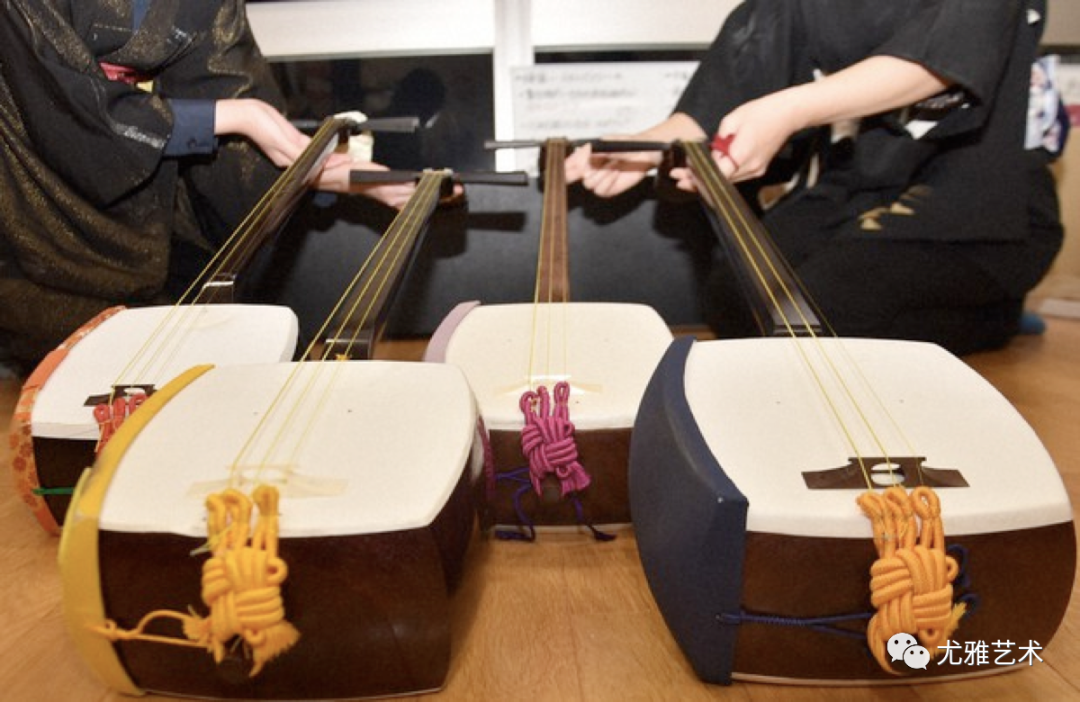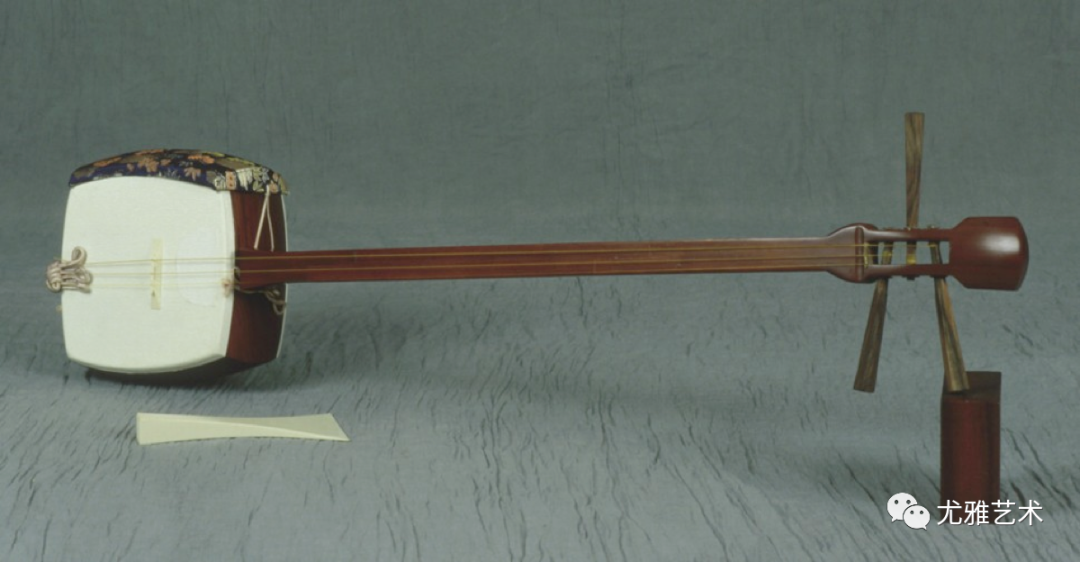
三弦(三味线),也称为三弦(三弦)或三味线(均意为“三弦”),是一种源自中国乐器三弦的三弦日本传统乐器。 它是用一种叫做 bachi 的拨子演奏的。The shamisen (三味線), also known as sangen (三絃) or samisen (all meaning "three strings"), is a three-stringed traditional Japanese musical instrument derived from the Chinese instrument sanxian. It is played with a plectrum called a bachi.

日语发音通常是 shamisen,但有时 jamisen 用作后缀时,根据规则的声音变化(例如 tsugaru-jamisen)。 在日本西部方言和一些江户时代的资料中,它被写成和读成三味线。The Japanese pronunciation is usually shamisen but sometimes jamisen when used as a suffix, according to regular sound change (e.g. tsugaru-jamisen). In Western Japanese dialects and several Edo period sources, it is both written and pronounced as samisen.

三味线的结构形状各不相同,具体取决于使用它的流派。 用于伴奏歌舞伎的乐器有细颈,有助于该流派对敏捷和精湛技艺的要求。 木偶戏和民歌伴奏用的琴颈更长更粗,以配合这些流派中更强劲的音乐。The construction of the shamisen varies in shape, depending on the genre in which it is used. The instrument used to accompany kabuki has a thin neck, facilitating the agile and virtuosic requirements of that genre. The one used to accompany puppet plays and folk songs has a longer and thicker neck instead, to match the more robust music of those genres.

三味线是一种弹拨弦乐器,它的结构类似于吉他或班卓琴的模型,琴颈和琴弦在共鸣体上伸展。 三弦琴的琴颈比吉他或班卓琴的琴颈无品且纤细。 身体,称为 dō(胎),类似于鼓,有一个中空的身体,前后覆盖着皮肤,就像班卓琴一样。 使用的皮肤取决于音乐的类型和演奏者的技能。 传统上,皮肤是用狗皮或猫皮制成的,猫皮更适合制作更精细的乐器;:257-258 尽管在整个 20 世纪使用动物皮很普遍,但从 2000 年代中期开始,这些皮的使用逐渐失宠 ,由于社会耻辱和熟练准备这些特殊毛皮的工人的减少。 当代的三味线皮通常是用塑料等合成材料制成的。The shamisen is a plucked stringed instrument Its construction follows a model similar to that of a guitar or a banjo, with a neck and strings stretched across a resonating body. The neck of the shamisen is fretless and slimmer than that of a guitar or banjo. The body, called the dō (胴), resembles a drum, having a hollow body that is covered front and back with skin, in the manner of a banjo. The skin used depends on the genre of music and the skill of the player. Traditionally, skins were made using dog or cat skin, with cat skin favored for finer instruments;: 257–258 though use of animal skins was common throughout the 20th century, use of these skins gradually fell out of favor, starting around the mid 2000s, due to social stigma and the decline of workers skilled in preparing these particular skins. Contemporary shamisen skins are often prepared with synthetic materials, such as plastic.

sao (棹),或三味线的琴颈,通常分为三或四块,可以装配并锁定在一起,大多数三味线都可以轻松拆卸。 三弦琴的琴颈是一根横跨鼓形琴身的单杆,部分突出于琴身的另一侧,充当琴弦的锚点。 用来上弦的弦轴又长又细,呈六角形; 虽然它们传统上是用象牙制成的,但由于象牙的稀缺性和贸易法规以及限制象牙的销售,现在许多是用其他材料制成的,例如木材和塑料。The sao (棹), or neck of the shamisen, is usually pided into three or four pieces that fit and lock together, with most shamisen made to be easily disassembled. The neck of the shamisen is a singular rod that crosses the drum-like body of the instrument, partially protruding at the other side of the body and acting as an anchor for the strings. The pegs used to wind the strings are long, thin and hexagonal in shape; though they were traditionally fashioned out of ivory, due to scarcity and trading regulations regarding and constricting the sale of ivory, many are now constructed from other materials, such as wood and plastic.

三味线的三根弦由丝绸(传统上)或尼龙制成。 它们被拉伸在乐器头部的钉子和固定在杆的末端的布制拉弦器之间,该杆伸出到身体的另一侧。 琴弦横跨琴身,通过琴桥或驹(驹)从琴身上抬起,琴桥直接靠在紧绷的皮肤上。 最低的琴弦故意放在乐器琴枕的较低位置,以产生嗡嗡声,这是一种被称为 sawari 的特有音色(有点让人想起西塔琴的“嗡嗡声”,称为 Jivari)。 dō 的上侧(当放在演奏者的膝盖上时)几乎总是由一个称为 dō kake 的盖子保护,演奏者经常在左手上戴一条小布带以方便在脖子上上下滑动,称为 yubikake。 被称为天神的乐器的头部也可以用盖子保护。 琴弦的材料取决于演奏者的技巧。 传统上使用丝弦。 但是,丝绸很容易在短时间内断裂,所以这是为专业表演保留的。 学生经常使用尼龙或“tetron”琴弦,它们比丝绸更耐用,而且更便宜。The three strings of the shamisen are made of either silk (traditionally) or nylon. They are stretched between the pegs at the head of the instrument, and a cloth tailpiece anchored at the end of the rod which protrudes on the other side of the body. The strings are stretched across the body, raised from it by means of a bridge, or koma (駒), which rests directly on the taut skin. The lowest string is purposefully laid lower at the nut of the instrument in order to create a buzz, a characteristic timbre known as sawari (somewhat reminiscent of the "buzzing" of a sitar, which is called Jivari). The upper side of the dō (when on the player's lap) is almost always protected by a cover known as a dō kake, and players often wear a little band of cloth on their left hand to facilitate sliding up and down the neck, known as a yubikake. The head of the instrument known as a tenjin may also be protected by a cover. The material of the strings will depend on the skill of the player. Traditionally, silk strings are used. However, silk breaks easily over a short time, so this is reserved for professional performances. Students often use nylon or 'tetron' strings, which last longer than silk, and are also less expensive.

